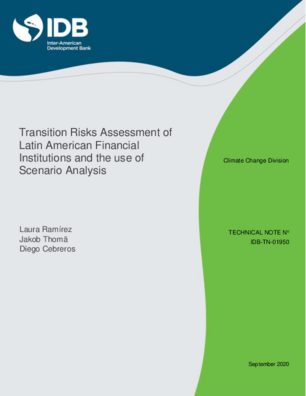Transition Risks Assessment by Latin American Financial Institutions and the Use of Scenario Analysis
Date
Sep 2020
Latin America is one of the most vulnerable regions to climate change. It is exposed to physical risks, which relate to changes in climate patterns and the increase in the occurrence and severity of extreme weather events, as well as transition risks, which relate to changes in policies, technologies and market prices that will materialize in the shift towards a low carbon economy. To identify the potential exposure to climate-related factors of financial portfolios, a new generation of methodologies have been developed in the past 5 years to connect the dots between financial portfolios and climate-related risks and overcome the caveats of traditional carbon metrics. Climate scenario analysis is one of these methodologies. It is used to assess the potential implications of the materialization of climate-related risks (both transition and physical) in financial portfolios. It helps financial institutions understand if their investment or lending strategy will be resilient as the climate changes, regulations evolve, new technologies emerge, and consumer behavior shifts.
Regulators, supervisors, and financial institutions networks in Latin America are assessing the uptake of scenario analysis and other risk assessment methodologies. The uptake of scenario analysis methodologies by financial institutions has been increasing over the past several years, the uptake of scenario analysis is, however, insufficient. This report supports the efforts made by these stakeholders by providing quantitative evidence on the relevance of climate-related risk for banks and investors in Latin America. It takes a closer look at how and which transition risks could affect the economy, local capital markets, and consequently financial portfolios of investors and banks in the largest financial markets in Latin America, namely Brazil, Chile, Colombia, Mexico and Argentina.
Regulators, supervisors, and financial institutions networks in Latin America are assessing the uptake of scenario analysis and other risk assessment methodologies. The uptake of scenario analysis methodologies by financial institutions has been increasing over the past several years, the uptake of scenario analysis is, however, insufficient. This report supports the efforts made by these stakeholders by providing quantitative evidence on the relevance of climate-related risk for banks and investors in Latin America. It takes a closer look at how and which transition risks could affect the economy, local capital markets, and consequently financial portfolios of investors and banks in the largest financial markets in Latin America, namely Brazil, Chile, Colombia, Mexico and Argentina.




